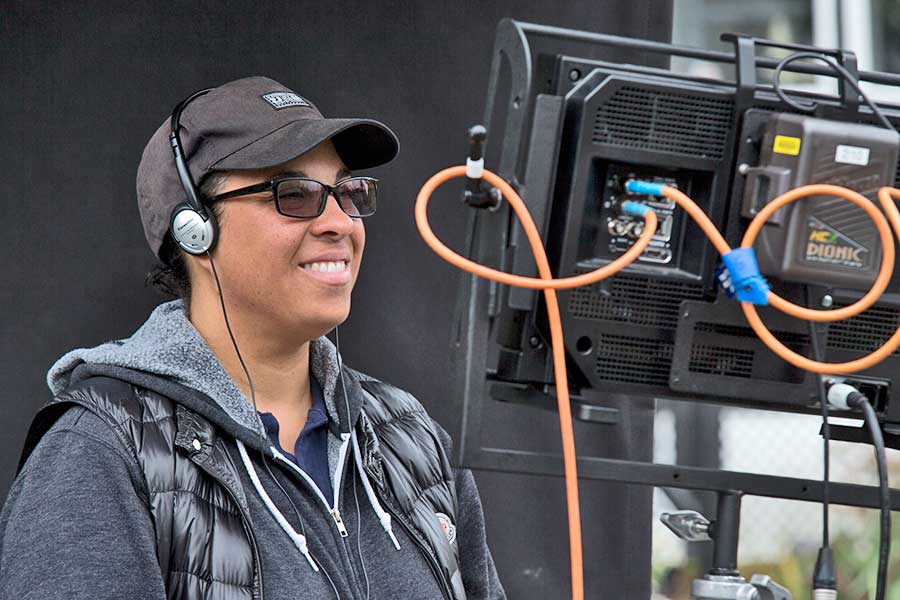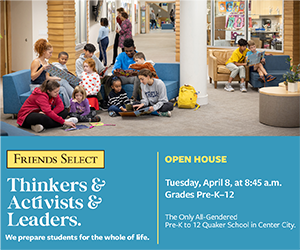Written and directed by lesbian filmmaker Angela Robinson, “Professor Marston and the Wonder Women,” opening Oct. 13 at Ritz Five, is a marvelous “Wonder Woman” origin story.
That said, it might not be the one comic-book fans expect. Based on a true story, this stylish period film recounts the polyamorous relationship the comic book’s creator, Dr. William Moulton Marston (Luke Evans), had with his wife Elizabeth (Rebecca Hall) and their lover/student, Olive Byrne (Bella Heathcote).
Marston generated controversy with his comic books because of their overly sexual and sadomasochistic content. The film depicts Marston defending “Wonder Woman” before offended and censorious child-book advocate Josette Frank (Connie Britton). Flashbacks reveal his polyamorous lifestyle and risqué sexual practices that informed the bondage, dominance, inducement and submission depicted in the comics.
The filmmaker convincingly captures the sexual energy between the three lovers, and plays up how the society was not ready to accept such forward-thinking ideas about sexuality and sexual identity. Robinson spoke with PGN about making “Professor Marston and the Wonder Women.”
PGN: Were you a big fan of “Wonder Woman”? How did this comic inspire you?
AR: I totally started as a “Wonder Woman” fan, which is how I came across the story of the Marstons. After I shot “D.E.B.S.,” Jordana Brewster gave me a book on Wonder Woman because she knew I was a fan. I read a chapter on the Marstons and it blew my mind.
PGN: What was your intention in relating the Marstons’ story?
AR: When I discovered their story, I was really struck by this incredible, unconventional love story at the heart of the “Wonder Woman” comic, and this character I loved. I was especially struck that they raised a family together, and lived together for a number of years. Elizabeth and Olive lived together for another 38 years [after Marston’s death]. That was emotional for me. I wanted to bring that to life. It’s been hidden from history.
PGN: “Professor Marston and the Wonder Women” depicts a relationship that, by contemporary (at the time) standards, was considered inappropriate, unconventional, immoral and illegal. Can you talk about your approach to the film?
AR: I really wanted to tell an organic love story between three people as simply as possible, with no judgment or editorializing about what they were doing. It was about how you feel when you fall in love. I wanted to tell it in an engaging and emotional way. I didn’t want to come at it with any self-judgments. They were complicated people. I wanted to approach their exploration of who they were and what they wanted to do and how they wanted to live. Representation is really important to me. The representations of polyamory or kink are not portrayed as kinky or salacious. I didn’t want to be exploitative at all. I wanted to approach the subject matter in a straightforward and emotional way.
PGN: Do you think, as Olive’s boyfriend Brant (Chris Conroy) suggests, that Bill and Elizabeth corrupted Olive?
AR: It was really important to me that all of the “antagonists” [Brant, Josette] made good points. I didn’t want to portray them as villains. I wanted to leave it to the audience. I wanted that debate to swirl through the movie. Elizabeth and William are challenged throughout. Should they be doing this? What are they thinking? I didn’t want to authorize their experience. I wanted it to be accessible. What would it be like to be in this situation and make these choices?
PGN: The film’s few sex scenes feature costumes, role play and fetishes, but it’s not overly kinky. Can you talk about your intention in depicting these scenes?
AR: I was really aware that the history of portraying kink on film is not great. It’s usually portrayed as something sad or sensational, negative or abhorrent. I didn’t want to do that with this film. I didn’t feel that was how they were. For the characters’ explorations of their sexuality, I set up a dialectic between fantasy and reality. When they explore the fetish, they live their true selves and are liberated; they enter this fantasy space together. Then they crash back down to reality, and the world and the limitations of who they are and who they are allowed to be in the world. Because the end game is “Wonder Woman,” she represents this notion of truth and freedom to be who you are. It all lined up for me.
PGN: You include many vivid images from the comic books in the film to “comment” on the action. Can you discuss how you chose those panels?
AR: I read through so many “Wonder Woman” comic books! What’s interesting is that Marston wrote “Wonder Woman” for seven years. He wasn’t a subtle guy. It wasn’t needle-in-a-haystack. It was panel after panel. I wanted to communicate how much and how over-the-top so much of the images are.
PGN: Do you think “Wonder Woman” fans will recalibrate how they watch and read her after seeing your film?
AR: Because of the renaissance of “Wonder Woman,” I feel it’s the perfect time to go back and look at the ideas and ideals that created her: A true-origin story of this character we all love conjured up by three very-real people.

